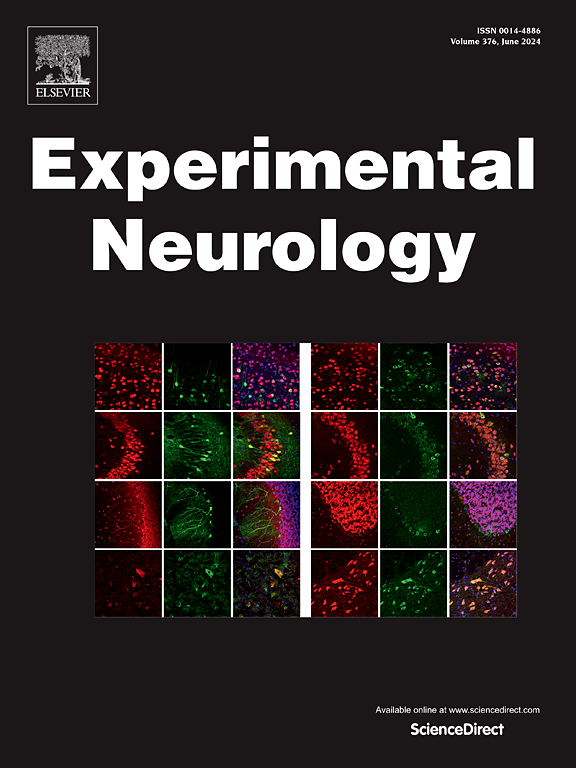致病性 SHQ1 变异会导致神经元发育和多巴胺能通路中断。
IF 4.2
2区 医学
Q1 NEUROSCIENCES
引用次数: 0
摘要
背景:在发育迟缓、肌张力障碍、癫痫和小头畸形患者中发现了SHQ1的复合杂合变异体,SHQ1是H/ACA核糖核蛋白(RNPs)的组装因子,参与重要的生物通路。我们研究了 SHQ1 在大脑发育和运动障碍中的作用:方法:使用短发夹RNA(shRNA)敲除SHQ1的表达,研究其对神经元的影响。通过宫内电穿孔将 Shq1 shRNA 和 WT 及突变体 SHQ1 的 cDNA 导入胚胎小鼠皮层的神经祖细胞。通过共免疫沉淀研究了SHQ1与H/ACA RNPs的核心蛋白DKC1之间的相互作用:结果:我们发现SHQ1在发育中的小鼠皮层中高表达。结果:我们发现 SHQ1 在发育中的小鼠大脑皮层中高表达,敲除 SHQ1 会影响大脑皮层神经元的迁移和神经元形态。此外,SHQ1基因敲除还损害了神经元的生长和体外对谷氨酸毒性的敏感性。SHQ1敲除后多巴胺能功能也会增强,这可能是细胞谷氨酸毒性增强的原因。大多数SHQ1变体削弱了它们与DKC1的结合能力,这意味着SHQ1变体可能会通过破坏H/ACA RNPs的组装和生物生成来影响大脑发育:结论:SHQ1通过上调多巴胺能通路和调节神经祖细胞及其神经元后代的行为,在大脑发育和多巴胺能功能中发挥着重要作用,可能导致患者肌张力障碍和发育迟缓。我们的研究深入揭示了 SHQ1 在神经元发育和多巴胺能功能中的作用,为 H/ACA RNPs 相关疾病提供了一种可能的致病机制。本文章由计算机程序翻译,如有差异,请以英文原文为准。
Pathogenic SHQ1 variants result in disruptions to neuronal development and the dopaminergic pathway
Background
Compound heterozygous variants of SHQ1, an assembly factor of H/ACA ribonucleoproteins (RNPs) involved in critical biological pathways, have been identified in patients with developmental delay, dystonia, epilepsy, and microcephaly. We investigated the role of SHQ1 in brain development and movement disorders.
Methods
SHQ1 expression was knocked down using short-hairpin RNA (shRNA) to investigate its effects on neurons. Shq1 shRNA and cDNA of WT and mutant SHQ1 were also introduced into neural progenitors in the embryonic mouse cortex through in utero electroporation. Co-immunoprecipitation was performed to investigate the interaction between SHQ1 and DKC1, a core protein of H/ACA RNPs.
Results
We found that SHQ1 was highly expressed in the developing mouse cortex. SHQ1 knockdown impaired the migration and neurite morphology of cortical neurons during brain development. Additionally, SHQ1 knockdown impaired neurite growth and sensitivity to glutamate toxicity in vitro. There was also increased dopaminergic function upon SHQ1 knockdown, which may underlie the increased glutamate toxicity of the cells. Most SHQ1 variants attenuated their binding ability toward DKC1, implying SHQ1 variants may influence brain development by disrupting the assembly and biogenesis of H/ACA RNPs.
Conclusions
SHQ1 plays an essential role in brain development and dopaminergic function by upregulating dopaminergic pathways and regulating the behaviors of neural progenitors and their neuronal progeny, potentially leading to dystonia and developmental delay in patients. Our study provides insights into the functions of SHQ1 in neuronal development and dopaminergic function, providing a possible pathogenic mechanism for H/ACA RNPs-related disorders.
求助全文
通过发布文献求助,成功后即可免费获取论文全文。
去求助
来源期刊

Experimental Neurology
医学-神经科学
CiteScore
10.10
自引率
3.80%
发文量
258
审稿时长
42 days
期刊介绍:
Experimental Neurology, a Journal of Neuroscience Research, publishes original research in neuroscience with a particular emphasis on novel findings in neural development, regeneration, plasticity and transplantation. The journal has focused on research concerning basic mechanisms underlying neurological disorders.
 求助内容:
求助内容: 应助结果提醒方式:
应助结果提醒方式:


